Lesbians, World War II and Beyond
Copyright (c) by Lee Roosevelt, 2008. All rights reserved.
When the United States entered World War II on December 7, 1941 Americans faced a new military threat on the home front. Unprecedented numbers of women emerged from the private sphere of the home or low end jobs into areas of the public realm previously only reserved for men.[1] This economic shift necessitated a dramatic reassessment of women’s role in American life and had a direct, multifaceted impact on the experiences of lesbian women.[2]
The Impact of World War II on Women
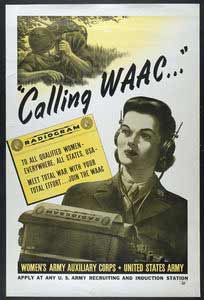
For the first time in history, the military began actively recruiting and integrating women into the armed services. In 1942, Congress passed a law allowing women into the Army, which in turn created the Women’s Army Corps (WAC).[4] The military had a vested interest in the work women could provide during war times. According to one Army official, “We have found difficulty in getting enlisted men to perform tedious duties anywhere nearly as well as women will do it”.[5] The promise of active participation into military life in reality meant that many women found themselves serving in traditionally feminine jobs such as clerical and technical work.[6]This was particularly true for black WACs who were assigned the most menial jobs such as kitchen, housekeeping, and laundry duties and were confined stateside until 1945.[7]
The prolific entrance of some women into the army paralleled the movements of other women into nontraditional jobs in the civilian labor force. Women contributed more than one-third of the labor force during the war, and in 1944 nearly half of all adult women worked at one time or another.[8]
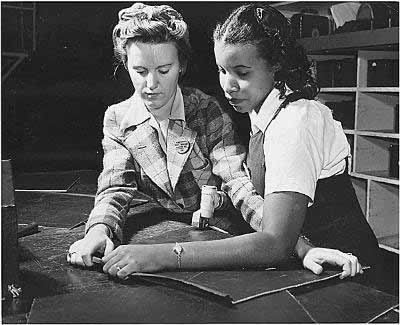
The need for full utilization of all resources during World War II brought large numbers of white, married women into the labor force and created opportunities for working class women and women of color to enter jobs previously denied to them.[10] Despite media campaigns showing middle class women turning in their aprons for overalls, the majority of women who entered the war production industry were working class women who had extensive pre-war work experience. For working class women the war drained the labor force of male laborers in fields that paid higher wages and offered more stimulating work than traditional female occupations and for many woman, had the potential for union representation.[11] Black women’s employment became slightly more diversified as many managed to leave domestic service for commercial service or factory work that paid more and had greater job stability.[12]
Lesbian Women on the Home Front
Boots of Leather, Slippers of Gold, written by Elizabeth Kennedy and Madeline Davis in 1994, is perhaps the most significant piece of work available that describes the experiences of lesbian women during World War II. The book is a result of 14 years of collaborative research and interviews between the authors and the 45 “narrators” of the story. Narrators remember World War II as having a tremendous impact on lesbian life by offering lesbians more opportunities for socializing and meeting other women.[13] This was not because lesbians suddenly gained access to the job market; many had been working since their teens.
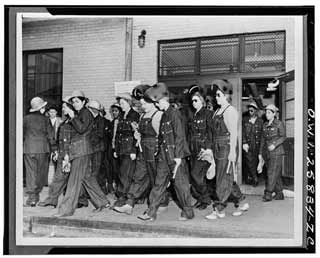
The narrators of Boots of Leather, Slippers of Gold felt that the important effect of the war was that it gave more independence to all women, thereby making lesbians more like other women and less easy to identify. Since all women were able to wear pants to work and to purchase them in stores off the rack, butches who only wore pants in the privacy of their home in the 1930s could now wear them on the streets.[15] For most of the narrators, who live in Buffalo , the army had little to offer. Buffalo was a thriving industrial center made even more so by the presence of war production and lesbians had ample opportunities for high-paying jobs. They had active social lives and with the men away in the war, they had more opportunity to be with women in the public world.[16]
The changes associated with World War II for women in general and specifically for lesbians manifested themselves in the proliferation of lesbian bars and the extensive social life that developed around them. Many straight women even went out to the bars for an evening of fun; some of who became regulars and developed temporary lesbian relationships until their husbands returned from the war.[17] While the gay bars began to proliferate during World War II, in the 1940s the mere presence of homosexuals was interpreted by the State Liquor Authority as constituting disorderly conduct. Gay bars, therefore, had to walk a fine line between allowing their gay patrons to express themselves enough to feel comfortable and continue patronizing the bar and not allowing so much gay behavior that it would attract attention from the public and the police.[18] However, in the 1940s, gay bars were opened primarily as business enterprises rather than with sympathy or concern for gay clientele and the owners were experienced business owners who were able to walk that line successfully leading to very few raids by the mid 1940s.[19]
Enlisted Lesbians
Despite the growing availability of high paying jobs and the formation of an active social environment in many areas of the country, many lesbian women found the armed services as place of expanding opportunity and exciting direction. The formation of the Women’s Army Corp provided a place for lesbian women within an otherwise wholly male institution. Rumors of difficult enrollment screenings for gay men deterred very few lesbians. Because of women’s marginal status in the military before World War II, neither the Army nor the Navy had developed policies or procedures concerning lesbian enrollment in the armed services.[20] Even on the home front, criminal law generally ignored lesbians and women were rarely prosecuted in court for engaging in sex acts with other women. At the onset of the war, psychiatrists and military officers reflected this history of invisibility and issued no policies or procedures for screening out lesbians.[21] The pressure to meet unfilled personnel quotas was also a significant force in keeping recruiting officers and examiners from prying into the sexual lives of women volunteers.[22] During entrance exams female masculinity, unlike male effeminacy, was not considered to be a disqualifying defect, reflecting the military’s need for women who could perform traditionally male jobs. “It should be noted,” a group of Marine Corps examiners at Camp LeJeune advised their colleagues, “that women showing a masculine manner may be perfectly normal sexually and excellent military material.”[23]
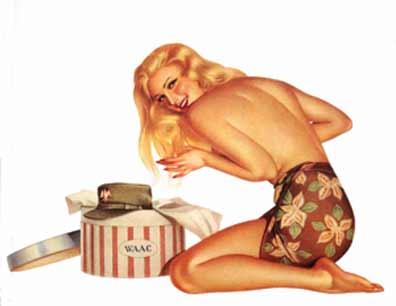
The Women’s Army Corp represented a pivotal turn in cultural understandings around gender and sexuality. As the culture of the 1940s grew increasingly anxious about women’s sexuality as a result of the shift in public/private spheres, and homosexuality in particular, the formation of the WAC sparked a storm of public speculation and concern as to the potential breakdown of heterosexual norms and sexuality morality which might result.[25] Historically, women had been most visibility associated with the military as prostitutes. The general public expressed fear that, in forming the WAC, the military as trying to create an organized coalition of prostitutes to service male GIs.[26] Print media of the World War II era supported a dual effort to maintain a sense of “normalcy” through prescriptions of control and containment of women’s sexuality, within and outside of the military, while simultaneously “normalizing” the drafting of women’s sexuality into the armed services.[27] The media both responded to and reinforced emergent cultural and political perceptions of a threat to the existing gender social structure. The response of Women’s Army Corps Director Colonel Oveta Culp Hobby was to challenge this by characterizing female soldiers as chaste and asexual.[28] Like advertising and other media elements, military propaganda emphasized traditional female qualities and roles. For example, a magazine article featuring the WAC declared, “You’ll like this girl. She does a man’s work…servicing airplanes, but she hasn’t lost any of her feminine sweetness or charm.”[29]
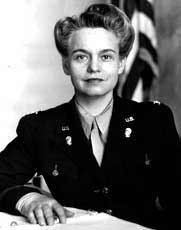
Public fear was that the WAC was either attracting women who were already “sexually deviant” or the experience of military life would make them that way.[31] This led Colonel Hobby to demand more strict screening and to determine the motivations of women wanting to join the WAC.[32] Hobby wanted to create an image of the WAC as chaste, strong, and moral women and the increasing number of working class lesbians within the WAC made that task difficult. Increased screening found that many women chose the WAC out of patriotism but additionally many women gave qualifying motives including “loves a uniform and what it stands for,” “always wanted to be a boy and join the army,” seeks “companionship of girls with similar patriotic desire,” and wants the “opportunity to mix with other girls” etc.[33] Despite this supposed increased screening for lesbians in the mid 1940s, when Pat Bond went to enlist in the WAC she recalled that the women “looked sort of like all my gym teachers in drag. Stockings, little earrings, her hair slicked back and very daintily done so you couldn’t tell she was a dyke, but I knew!” Bond explained that many “butch” lesbians she knew applied for the WAC “wearing men’s clothes” and despite these women’s masculine appearances the psychiatrists admitted them.[34]
“You know, I never entered the military with the idea of meeting other lesbians or having any sort of affairs or anything. I entered the military knowing I was a lesbian, but also knowing that I wanted to do what was right by military standards and stay there! But, by God, when I got into basic, I thought I had transferred to hog heaven! But I was smart enough to know that doing anything would be my downfall."[35]
Once in the military lesbians quickly created social networks and a portable environment filled with other WAC lesbians and local lesbians. Mannerisms and coded language were a few of the ways in which lesbians found one another and a lesbian community.
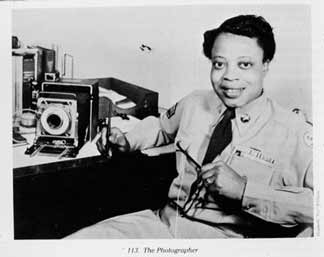
WAC lesbians and their female friends went into bars, cafes, restaurants, and movie theaters unescorted by men without attracting attention because of the increase of women on the streets. They were able to meet women everywhere who had replaced men as bus operators, streetcar conductors, taxi drivers, and bartenders in hotels and taverns.[37] In many cities lesbian WACs had a difficult time finding predominantly female bars due to the clamp down of women’s public heterosexual activity, barring those who appeared to be “Victory Girls” from hanging out in bars.[38] The service clubs near military bases developed some of the same attributes seen in the lesbian bar scene among civilians which included an increasingly rough and tough lesbian crowd and a strong preference for butch/femme identities. Lesbians met at the service clubs and paired up into butch/femme couples or remained unattached. Some lesbian groups were made up entirely of butches. Rusty Brown, who was a Navy mechanic during the war said that she “automatically went to the table with the butches” so that she could “find out who was going with who – I didn’t want to get my head knocked off!”[39]
Army policies provided a space in which lesbians could exist, recognize one another, and develop their own culture. Yet this existence was an extremely precarious one, framed by army regulations that also provided for the dishonorable discharge of homosexuals, male and female. A hostile military environment for gay men and lesbian women was not unique to World War II. Abuse and expulsion of homosexuals in the United States military environment were recording from the beginning of the republic when General George Washington issued orders as early as 1778 to remove defendants court martialed for sodomy and perversion.[40] Army regulations providing dishonorable discharge of homosexuals were rarely used against lesbians in the WAC and the WAC officers were warned to consider this action only in the most extreme of situations.[41] Towards the late 1940s purging of lesbians from the military became increasingly problematic. Many women were forced to deny knowing any of their friends or marry gay men to pass as heterosexual. Butch service women, because of their greater fit with popular lesbian stereotypes, were more likely to be targeted as female homosexuals in discharge proceedings.[42] By the mid 1950s Navy official’s secretly acknowledged that the homosexual discharge rate had become “much higher for the female than the male.”[43]
During World War II the personnel shortages had allowed large numbers of American women to enlist in the armed forces. After the war when women were encouraged to return to civilian life and resume traditional gender roles, those unmarried women who chose to remain in the military or who enlisted during peacetime increasingly stood out as members of a deviant group that was easily stereotyped as lesbian and increasingly subjected to dishonorable discharge proceedings.[44]
Post-War Lesbians
The end of World War II in mid 1945 brought new changes to the role of women in the public sphere that had a direct impact on lesbian women in the United States.
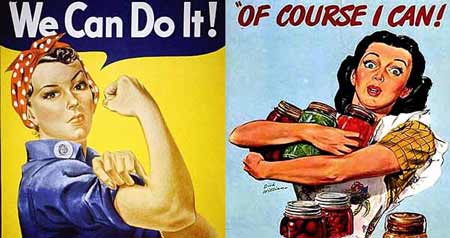
The dominant media image of the woman war worker’s eager return to the home belied the reality of women’s resistance to losing their improved status in the work force as well as the fact that many women now needed to find alternative employment.[46] A survey taken in 1944 revealed that almost 80% of women in the war production areas planned to remain in the labor force after the war, and specifically wanted to keep the jobs they were performing during the war.[47] World War II also brought serious attention to the principle of equal pay for equal work for the first time. Although thwarted in Congress, women’s organizations and labor unions pushed through equal pay laws in ten states during the 1940s (Hartmann 1995, 18).
Despite these forward efforts, the acceptance of visible women in the public sphere was becoming increasingly frowned upon. Having lived through the difficult years of the Depression, World War II, and the impending threat of nuclear war, the majority of Americans of all classes were committed to creating a “happy and secure” domestic life. Viable alternatives to marriage did not exist for women in the post war period, and single women were subject to social disapproval if not ostracism.[48] The aggressive harassment of lesbians and gays was connected to this glorification of the nuclear family and domestic sphere. Homophobia became a way of reinstituting male dominance and strict gender roles that had been disrupted by the war.[49]
Many lesbians who came out in the 1950s, unlike those who had come out in the 1930s and 1940s, met their first lesbians when they joined the armed services.[50] As seen through the work of Kennedy and Davis, when these women returned from the armed services they made a radical break from their closeted relatives of the early 1940s. The increased visibility unquestionably expanded the presence of lesbians in post war America . As they affirmed their right to live as public lesbians, they made it easier for other lesbians to find them, and more difficult for the heterosexual community to ignore them.[51] This was accomplished through in increasingly flourishing bar life that had fewer raids and was becoming more racially diverse. Additionally, the Buffalo lesbian community began reaching out to newcomers. This ability and desire for lesbians to reach out was a new development of the 1950s and although it seems like a small matter, in the context of severe oppression, it suggests a significant transformation in lesbian consciousness.[52] The Black lesbian community during the 1950s did its own active outreach to newcomers. Singer and male impersonator Jacki Jordan went out of her way to introduce young lesbians to the newly opened lesbian bars in the Black section of Buffalo . While none of these bars were exclusively Black they had a sizable Black clientele which represents a large public transition.
Tough Butches
The changes in the 1950s Buffalo lesbian community are best symbolized by the appearance of the new style of butch, a women who dressed in working-class male clothes for as much of the time as she possibly could, and who went to the bar every night, not just on weekends.[53] The 1940s strategy of separating social life from work and family life as much as possible was no longer acceptable in the 1950s.
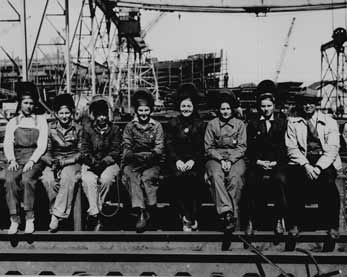
The tough bar butches of the 1950s would not divide their lives in order to maintain a steady job or to placate family. By not denying who they were and looking “queer” as much of the time as possible tough bar lesbians drastically reduced their options for work and their chances of partaking in the upward mobility being experienced around them.[55] The tough bar butches did not conform to the dress code required for most jobs, particularly well paying, white-collar jobs, nor did they conform to the moral values of the middle class. These characteristics were what gave the tough bar butches the unmistakably working-class character that became their image. Because of their tough, masculine appearance and the fact that they were more visible than lesbians of previous decades, tough bar lesbians became increasingly targeted for attacks.[56] The tough bar lesbians responded with frequent fights with the straight world and amongst their own social network. Alcohol, insecurity, and repression, in combination with the tough butch image, made fights among tough and rough lesbians a prominent part of the 1950s landscape which increased concern and attention from the larger culture.[57]
Criminalization vs. Treatment
The work of George Henry and Jan Gay in the early 1940s set up an institutionalized framework where gay men and lesbian women were seen as social deviants in need or psychiatric intervention. While taking part in the Committee for the Study of Sex Variants George Henry met Jan Gay who had compiled case histories of over 300 lesbians. The two of them worked together on a study that would eventually become Sex Variants: A Study of Homosexual Patters. Despite using Gay’s interview methodology and her being the contact person who recruited and initially interviewed all the participants, but in particular the lesbians, she was never given credit in the book and was referred in his other writings as his “research assistant". The study started as a collaborative effort between Henry, Gay, and the lesbian and gay study subjects with the common goal of decriminalization. The reality of Henry’s final published work was that while Henry wanted to decriminalize homosexuality, it was with the expressed purpose of legitimizing the profession of psychiatry to gain authority over homosexual treatment as a medical issue, rather than a legal issue. Henry viewed the family unit at the cause of homosexuality and found that the individuals he studied were “developmentally damaged individuals, victims of poor parenting and the breakdown of the family in times of rapid social change.”[58] As a result Henry felt that there was no cure for homosexuality and that the focus should be on prevention of action rather than treatment.
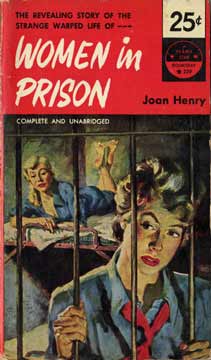
The ramifications of Henry’s study combined with a post war effort to reinstitute gender roles, and the presence of the tough bar lesbian meant that an increasing number of lesbian women were entering the prison system. After World War II, criminologists depicted lesbian inmates as menacing social types which lead to a conflation between women’s prisons and lesbianism.[60] Prior to World War II the prison system did not acknowledge the presence of lesbian behavior in the prison system. However, the increased arrests associated with prostitution during World War II and the increased presence of the tough bar lesbian lead to prison overcrowding. In the post war decade, the relative tolerance or inacknowledgement of prison lesbianism gave way to greater surveillance and condemnation. This transition can be seen in U.S. popular and political culture in magazines, pulp novels, and movies where the, previously, comic and benign lesbian gave way to the dangerously aggressive lesbian criminal. By the 1950’s the term “women’s prison” was synonymous with lesbian aggression. This association between lesbianism and criminality may have served as a cultural warning to women examining their own sexuality. Living this image mean becoming part of a criminal underworld, losing class, race, and privilege.[61].
Conclusion
World War II represented a time of dramatic change in sexual and gender social norms. The impact of the war and its opportunities meant an equally dramatic shift in the visibility of lesbian women. Lesbian women continued to develop their own, more public, forms of social support and an environment in which they could coexist in a heterosexually dominated world. This willingness to live a more public life was threatening to the existing power structures but the post war period represented an enormous shift in lesbian consciousness and marked the beginning of a movement of solidarity and pride in being part of a community.
References
- ↑ Marilyn E. Hegarty,“Patriot or Prostitute? Sexual Discourses, Print Media, and American Women during World War II”, Journal of Women's History 10: 112-136, (1998) p.112
- ↑ Maureen Honey, Creating Rose the Riveter: Class, Gender, and Propaganda during World War II. (Amherst: The University of Massachusetts Press, 1984) p.1.
- ↑ http://americanhistory.si.edu/militaryhistory/img/media/620_l.jpg
- ↑ Mary Ann Humphrey,My Country, My Right To Serve: Experiences of Gay Men and Women In the Military, World War II to the Present, (New York : Harper Collins, 1990) p.,1.
- ↑ Susan Hartmann, “Women, War, and the Limits of Change” National Forum 74: pp. 15-18 (1995), p. 16.
- ↑ Allan Berube, Coming Out Under Fire: The History of Gay Men and Women In World War II(New York : The Free Press, 1990) p.58.
- ↑ Hartmann, “Women, War, and the Limits of Change” p.16.
- ↑ Hartmann, “Women, War, and the Limits of Change” p.16.
- ↑ Image courtesy of Franklin D. Roosevelt Library © Jone Lewis 2001. http://z.about.com/d/womenshistory/1/0/K/5/1940s_aviation.jpg
- ↑ Leisa Meyer, “Creating G.I. Jane: The Regulation of Sexuality and Sexual Behavior in the Women’s Army Corps during World War II” pp.66-84 in Martha Vicinus, William D. Rowley eds. Lesbian Subjects (Bloomington: Indiana University Press, 1996) p.66
- ↑ Honey, Creating Rose the Riveter: Class, Gender, and Propaganda during World War II p. 21.
- ↑ Hartmann, “Women, War, and the Limits of Change” p.16.
- ↑ Elizabeth Lapovsky and Madeline Davis, Boots of Leather, Slippers of Gold (New York : Penguin, 1994) p.38.
- ↑ http://lcweb2.loc.gov/cgi-bin/query/i?pp/fsaall:@filreq(@field(NUMBER+@band(fsa+8e01109))+@field(COLLID+fsa)):displayType=1:m856sd=fsa:m856sf
- ↑ Kennedy and Davis, Boots of Leather, Slippers of Gold p.39.
- ↑ Kennedy and Davis, Boots of Leather, Slippers of Gold p.39.
- ↑ Kennedy and Davis, Boots of Leather, Slippers of Gold p.39.
- ↑ Kennedy and Davis, Boots of Leather, Slippers of Gold1994, p.40.
- ↑ Kennedy and Davis, Boots of Leather, Slippers of Gold p.41.
- ↑ Berube, Creating G.I. Jane: The Regulation of Sexuality and Sexual Behavior in the Women’s Army Corps during World War II p.28.
- ↑ Berube, Coming Out Under Fire: The History of Gay Men and Women In World War II p.28.
- ↑ Berube, Coming Out Under Fire: The History of Gay Men and Women In World War II p.29.
- ↑ Berube, Coming Out Under Fire: The History of Gay Men and Women In World War II p.29.
- ↑ http://www.camera-werks.com/VARGAS_WAAC-CLASSIC.jpg
- ↑ Meyer, “Creating G.I. Jane: The Regulation of Sexuality and Sexual Behavior in the Women’s Army Corps during World War II” p.68.
- ↑ Meyer, “Creating G.I. Jane: The Regulation of Sexuality and Sexual Behavior in the Women’s Army Corps during World War II” p.66.
- ↑ Hegarty, “Patriot or Prostitute? Sexual Discourses, Print Media, and American Women during World War II” p.113.
- ↑ Meyer, “Creating G.I. Jane: The Regulation of Sexuality and Sexual Behavior in the Women’s Army Corps during World War II” p.66.
- ↑ Hartmann 1995, “Women, War, and the Limits of Change” p.17.
- ↑ http://199.236.85.13/H&C/History/images/COL_Hobby_1943.jpg
- ↑ Meyer, "Creating G.I. Jane: The Regulation of Sexuality and Sexual Behavior in the Women’s Army Corps during World War II” p.96.
- ↑ Berube, Coming Out Under Fire: The History of Gay Men and Women In World War II 1990, p.30.
- ↑ Berube, Coming Out Under Fire: The History of Gay Men and Women In World War II p.30.
- ↑ Berube, Coming Out Under Fire: The History of Gay Men and Women In World War II p.32.
- ↑ Mary Ann Humphrey, My Country, My Right To Serve: Experiences of Gay Men and Women In the Military, World War II to the Present (New York: Harper Collins, 1990) p.11.
- ↑ http://www.cla.purdue.edu/WAAW/Palmquist/Gallery/gallery3-m.jpg
- ↑ Berube 1990, Coming Out Under Fire: The History of Gay Men and Women In World War II p.108.
- ↑ Berube, Coming Out Under Fire: The History of Gay Men and Women In World War II p.243.
- ↑ Berube, Coming Out Under Fire: The History of Gay Men and Women In World War II p.104.
- ↑ Humphrey, My Country, My Right To Serve: Experiences of Gay Men and Women In the Military, World War II to the Present p.xxiii.
- ↑ Meyer, Creating G.I. Jane: The Regulation of Sexuality and Sexual Behavior in the Women’s Army Corps during World War II p.76.
- ↑ Meyer, Creating G.I. Jane: The Regulation of Sexuality and Sexual Behavior in the Women’s Army Corps during World War II p.77.
- ↑ Berube, p.263.
- ↑ Berube, Coming Out Under Fire: The History of Gay Men and Women In World War II p.262.
- ↑ http://www.girlbits.com/historycd/worldwartwoposters_ad/pic1.jpg
- ↑ Honey, Creating Rose the Riveter: Class, Gender, and Propaganda during World War II p.23.
- ↑ Honey, Creating Rose the Riveter: Class, Gender, and Propaganda during World War II p.23.
- ↑ Kennedy and Davis, Boots of Leather, Slippers of Gold p.69.
- ↑ Kennedy and Davis, Boots of Leather, Slippers of Gold p.70.
- ↑ Kennedy and Davis, Boots of Leather, Slippers of Gold p.77.
- ↑ Kennedy and Davis, Boots of Leather, Slippers of Gold p.77.
- ↑ Kennedy and Davis, Boots of Leather, Slippers of Gold p.76.
- ↑ Kennedy and Davis, Boots of Leather, Slippers of Gold p.68.
- ↑ http://www.archives.gov/research/ww2/photos/images/ww2-22.jpg
- ↑ Kennedy and Davis,Boots of Leather, Slippers of Gold p.82.
- ↑ Kennedy and Davis, Boots of Leather, Slippers of Gold p.90.
- ↑ Kennedy and Davis, Boots of Leather, Slippers of Gold p.91-92.
- ↑ Henry Minton, Departing from Deviance: A History of Homosexual Right and Emancipatory Science in America(Chicago: University of Chicago Press, 2001).
- ↑ http://z.about.com/d/lesbianlife/1/0/N/3/prison.jpg
- ↑ Estelle Freedman, “The Prison Lesbian: Race, Class, and the Construction of the Aggressive Female Homosexual, 1915-1965” Feminist Studies 22: pp.397 - 423. (1996),p.397.
- ↑ Freedman, “The Prison Lesbian: Race, Class, and the Construction of the Aggressive Female Homosexual, 1915-1965” p.415.